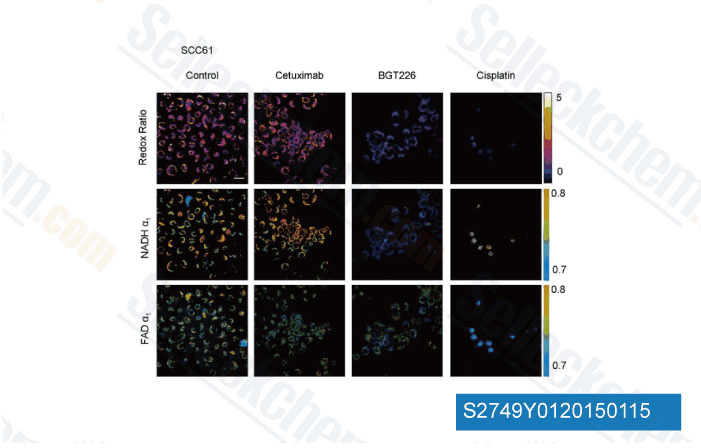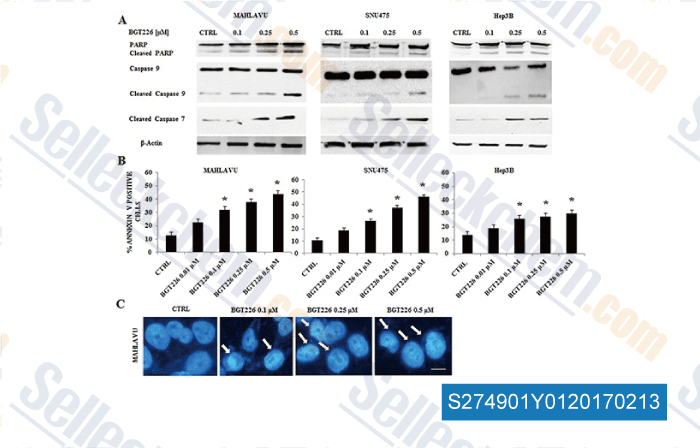|
How to Cite 1. For In-Text Citation (Materials & Methods): 2. For Key Resources Table: |
||
|
Toll Free: (877) 796-6397 -- USA and Canada only -- |
Fax: +1-832-582-8590 Orders: +1-832-582-8158 |
Tech Support: +1-832-582-8158 Ext:3 Please provide your Order Number in the email. We strive to reply to |
Technical Data
| Formula | C28H25F3N6O2.C4H4O |
||||||||||
| Molecular Weight | 650.6 | CAS No. | 1245537-68-1 | ||||||||
| Solubility (25°C)* | In vitro | DMSO | 30 mg/mL (46.11 mM) | ||||||||
| Water | Insoluble | ||||||||||
| Ethanol | Insoluble | ||||||||||
| In vivo (Add solvents to the product individually and in order) |
|
||||||||||
|
* <1 mg/ml means slightly soluble or insoluble. * Please note that Selleck tests the solubility of all compounds in-house, and the actual solubility may differ slightly from published values. This is normal and is due to slight batch-to-batch variations. * Room temperature shipping (Stability testing shows this product can be shipped without any cooling measures.) |
|||||||||||
Preparing Stock Solutions
Biological Activity
| Description | BGT226 (NVP-BGT226) maleate is a novel class I PI3K/mTOR inhibitor for PI3Kα/β/γ with IC50 of 4 nM/63 nM/38 nM. Phase 1/2. | ||||||||
|---|---|---|---|---|---|---|---|---|---|
| Targets |
|
||||||||
| In vitro | The anti-proliferative and pro-apoptotic effects of NVP-BGT226 are independent of bcr-abl status. The activation of the AKT/mTOR signal cascade is suppressed by NVP-BGT226 in a concentration- and time-dependent manner. Flow cytometric analysis exhibits an accumulation of cells in the G(0)-G(1) phase with concomitant loss in the S-phase. NVP-BGT226 displays potent growth-inhibitory activity against all tested cell lines including SCC4, TU183 and KB cell lines with the IC50 ranging from 7.4 to 30.1 nM. Notably, both Detroit 562 and HONE-1 cells, which express PIK3CA mutation H1047R, are still sensitive to the growth-inhibitory effect of NVP-BGT226 treatment. In addition, the sensitivity to NVP-BGT226 between HONE-1 cells. Results of the terminal deoxynucleotidyl transferase-mediated dUTP nick end labeling (TUNEL) assay and the analysis of caspase 3/7 and PARP indicates that NVP-BGT226 induces cancer cell death through an apoptosis-independent pathway. NVP-BGT226 induces autophagy as indicated by the aggregation and upregulation of the microtubule-associated protein light chain 3B-II, and p62 degradation. Gene silencing of Beclin1 or cotreatment of the autophagosome inhibitor, 3-methyladenine, inhibits the NVP-BGT226-induced autophagy and leads to the retrieval of colony survival.[2] NVP-BGT226 inhibits growth in common myeloma cell lines and primary myeloma cells (such as NCI-H929, U266, RPMI-8226 and OPM2 MM cell lines) at nanomolar concentrations in a time-dependent and dose-dependent manner. NVP-BGT226 inhibits phosphorylation of protein kinase B (Akt), P70S6k and 4E-BP-1 in a time-dependent and dose-dependent manner. The stimulatory effect of insulin-like growth factor 1, interleukin-6 and conditioned medium of HS-5 stromal cells on myeloma cell growth is completely abrogated by NVP-BGT226. Inhibition of phosphoinositol-3-kinase/mammalian target of rapamycin by NVP-BGT226 is highly effective, and NVP-BGT226 represents a potential new candidate for targeted therapy in multiple myeloma. Combined inhibition of PI3K and mammalian target of rapamycin (mTOR) by NVP-BGT226 has been proven to be very effective in terms of induction of apoptosis and inhibition of proliferation. [3] In another study, after 24 hours, 86.9% MiaPaCa-2 100 nM NVP-BGT226 treated cells arrests at the G0/G1 phase compared to 55.6% of control cells. [4] |
||||||||
| In vivo | In a xenografted animal model, NVP-BGT226 significantly delays tumor growth in a dose-dependent manner, along with suppressed cytoplasmic expression of p-p70 S6 kinase and the presence of autophagosome formation. NVP-BGT226 inhibits tumor growth in a dose-dependent manner in a FaDu cell xenografted mouse model. Oral administration of NVP-BGT226 at 2.5 and 5 mg/kg for 3 weeks causes 34.7% and 76.1% reduction of the tumor growth on day 21, respectively (compared with control). NVP-BGT226 displays comparable inhibition against tumor growth to rapamycin. The final volume of both groups is significantly smaller than those treated with LY294002 (a PI3K inhibitor) or the control. [2] |
Protocol (from reference)
| Cell Assay: |
|
|---|---|
| Animal Study: |
|
References
|
Customer Product Validation

-
Data from [ Cancer Lett , 2014 , 348(1-2), 38-49 ]

-
Data from [ PLoS One , 2014 , 9(3), e90746 ]

-
Data from [ PLoS One , 2014 , 9(3), e90746 ]

-
Data from [ , , Oncotarget, 2015, 6(19):17147-60. ]
Selleck's BGT226 (NVP-BGT226) maleate Has Been Cited by 12 Publications
| Heterogeneous Activation of Signaling Pathways and Therapeutic Vulnerabilities in KSHV-Associated Primary Effusion Lymphoma Cell Lines [ J Med Virol, 2025, 97(8):e70534] | PubMed: 40751690 |
| Role of the PI3K/AKT signaling pathway in the cellular response to Tumor Treating Fields (TTFields) [ Cell Death Dis, 2025, 16(1):210] | PubMed: 40148314 |
| PIK Your Poison: The Effects of Combining PI3K and CDK Inhibitors against Metastatic Cutaneous Squamous Cell Carcinoma In Vitro [ Cancers (Basel), 2024, 16(2)370] | PubMed: 38254859 |
| High-throughput and targeted drug screens identify pharmacological candidates against MiT-translocation renal cell carcinoma [ J Exp Clin Cancer Res, 2023, 42(1):99] | PubMed: 37095531 |
| A high-throughput screening platform identifies novel combination treatments for Malignant Peripheral Nerve Sheath Tumors [ Mol Cancer Ther, 2022, molcanther.MCT-21-0947-A.2021] | PubMed: 35511749 |
| Co-targeting PI3K, mTOR, and IGF1R with small molecule inhibitors for treating undifferentiated pleomorphic sarcoma. [ Cancer Biol Ther, 2017, 18(10):816-826] | PubMed: 29099264 |
| Healthy CD4+ T lymphocytes are not affected by targeted therapies against the PI3K/Akt/mTOR pathway in T-cell acute lymphoblastic leukemia. [ Oncotarget, 2016, 7(34):55690-55703] | PubMed: 27494886 |
| Synergistic effects of selective inhibitors targeting the PI3K/AKT/mTOR pathway or NUP214-ABL1 fusion protein in human Acute Lymphoblastic Leukemia. [Simioni C, et al. Oncotarget, 2016, 7(48):79842-79853] | PubMed: 27821800 |
| The PI3K/Akt Pathway Regulates Oxygen Metabolism via Pyruvate Dehydrogenase (PDH)-E1α Phosphorylation [Cerniglia GJ, et al. Mol Cancer Ther, 2015, 14(8):1928-38] | PubMed: 25995437 |
| The novel dual PI3K/mTOR inhibitor NVP-BGT226 displays cytotoxic activity in both normoxic and hypoxic hepatocarcinoma cells. [Simioni C, et al. Oncotarget, 2015, 6(19):17147-60] | PubMed: 26003166 |
RETURN POLICY
Selleck Chemical’s Unconditional Return Policy ensures a smooth online shopping experience for our customers. If you are in any way unsatisfied with your purchase, you may return any item(s) within 7 days of receiving it. In the event of product quality issues, either protocol related or product related problems, you may return any item(s) within 365 days from the original purchase date. Please follow the instructions below when returning products.
SHIPPING AND STORAGE
Selleck products are transported at room temperature. If you receive the product at room temperature, please rest assured, the Selleck Quality Inspection Department has conducted experiments to verify that the normal temperature placement of one month will not affect the biological activity of powder products. After collecting, please store the product according to the requirements described in the datasheet. Most Selleck products are stable under the recommended conditions.
NOT FOR HUMAN, VETERINARY DIAGNOSTIC OR THERAPEUTIC USE.
